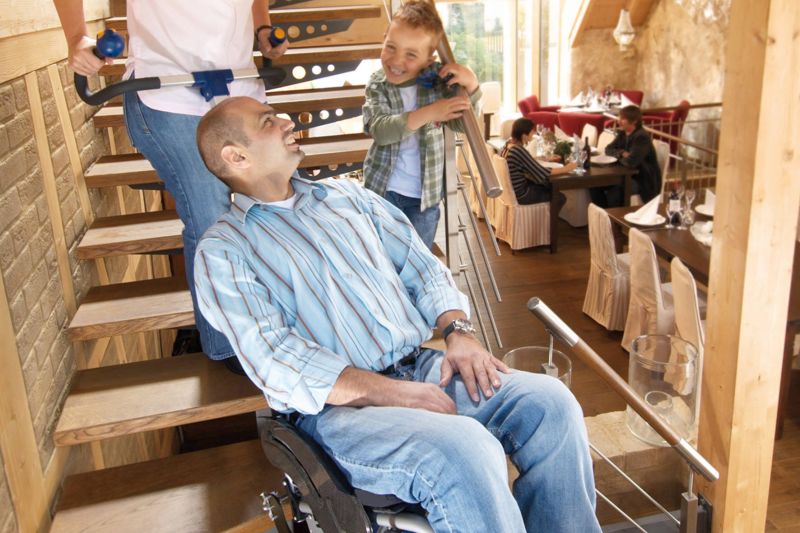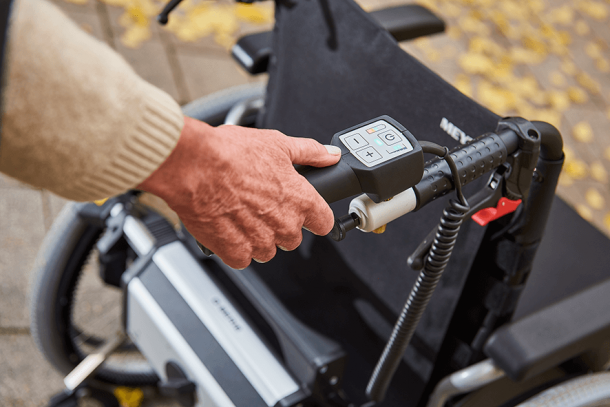What is a stair climber for wheelchairs?
Summary: how to choose the right wheelchair
The following aspects are important when purchasing a wheelchair:
- Type of wheelchair: Based on mobility impairment and place of use.
- Seating comfort and ergonomics: Adjustability, upholstery and positioning.
- Size and weight: Lightweight, foldable models for easy transportation.
- Safety features: Brakes, reflective elements and standards.
- Service and spare parts: Advice from specialist dealers and ensuring availability.
A stair climber for wheelchairs, also known as a mobile stair climber, is an aid that has been specially developed to transport people in wheelchairs up and down stairs. It contains a drive unit in which the motor is located and one or two climbing legs.
A bracket attached to the rear of the wheelchair allows the user's own wheelchair to be securely attached to the stair climber. It is operated by an attendant who controls the mobile stair climber. This technical solution improves the mobility and independence of people with reduced mobility and increases their quality of life.
Advantages and possible uses of a stair climber for wheelchairs
Summary: how to choose the right wheelchair
The following aspects are important when purchasing a wheelchair:
- Type of wheelchair: Based on mobility impairment and place of use.
- Seating comfort and ergonomics: Adjustability, upholstery and positioning.
- Size and weight: Lightweight, foldable models for easy transportation.
- Safety features: Brakes, reflective elements and standards.
- Service and spare parts: Advice from specialist dealers and ensuring availability.
A stair climber for wheelchairs offers numerous advantages. It is mobile, flexible and adaptable, which means that it can be attached to your own wheelchair. A lightweight and dismountable design makes it easy to transport - it even fits in the trunk of a car. This makes an electric stair climber a practical alternative to stair lifts and stair crawlers.
Whether straight or spiral staircases, indoors or outdoors, at home or in public buildings such as doctors' surgeries, a stair climber is a useful companion. It enables outings with family and friends and significantly improves the mobility and independence of wheelchair users.

Functionality and technology of an electric stair climber for wheelchairs
Summary: how to choose the right wheelchair
The following aspects are important when purchasing a wheelchair:
- Type of wheelchair: Based on mobility impairment and place of use.
- Seating comfort and ergonomics: Adjustability, upholstery and positioning.
- Size and weight: Lightweight, foldable models for easy transportation.
- Safety features: Brakes, reflective elements and standards.
- Service and spare parts: Advice from specialist dealers and ensuring availability.
An electric stair climber for wheelchairs works with a special motor in the drive unit that controls the climbing process. The climbing legs or the climbing foot of a stair climber are designed so that they touch down safely on every step. Safety brakes also contribute to safety by preventing slipping on each step.
A control panel on the handle of the stair climber enables single step control and continuous climbing mode, with infinitely variable speed adjustment. An on/off switch and a safety chip provide protection against unauthorized use. A powerful rechargeable battery is inserted into the drive unit for operation.

Tips for choosing the right stair climbing aid for your wheelchair
Summary: how to choose the right wheelchair
The following aspects are important when purchasing a wheelchair:
- Type of wheelchair: Based on mobility impairment and place of use.
- Seating comfort and ergonomics: Adjustability, upholstery and positioning.
- Size and weight: Lightweight, foldable models for easy transportation.
- Safety features: Brakes, reflective elements and standards.
- Service and spare parts: Advice from specialist dealers and ensuring availability.
Choosing the right stair climbing aid for your wheelchair can be a challenge. It is important to seek careful advice and try out different models. Detailed instruction on how to use the devices is also essential for your safety and your confidence in using the aid.
Consider the technical data of the devices, especially the weight and power. A lightweight device is easier to transport, while a powerful device offers greater safety. Additional benefits such as a single step control can be a great help, especially for beginners.
Make sure that the stair climber can be attached to your wheelchair and is suitable for your needs. A medical supply store or the manufacturer of the stair climber can help you with the selection and ensure that the stair climber meets your requirements. As a rule, most manual wheelchairs can easily be fitted with a mobile stair climber.
Important safety aspects when using the stair climber
Summary: how to choose the right wheelchair
The following aspects are important when purchasing a wheelchair:
- Type of wheelchair: Based on mobility impairment and place of use.
- Seating comfort and ergonomics: Adjustability, upholstery and positioning.
- Size and weight: Lightweight, foldable models for easy transportation.
- Safety features: Brakes, reflective elements and standards.
- Service and spare parts: Advice from specialist dealers and ensuring availability.
When using the stair climber, you should read the operating instructions carefully and familiarize yourself with the manufacturer's instructions. It is important that only trained persons operate the device and that you feel safe before using it to its full extent. Practice first without an occupant and at low speed to familiarize yourself with the single speed control and the general routine.
Handle the stair climber with care to avoid possible damage or accidents. Any problems should be reported immediately to the medical supply store or the manufacturer. Do not hesitate to contact your medical supply store or the manufacturer's contact person if you have any questions about handling or need a refresher course.
Care and maintenance of the electric stair climber for wheelchairs
Summary: how to choose the right wheelchair
The following aspects are important when purchasing a wheelchair:
- Type of wheelchair: Based on mobility impairment and place of use.
- Seating comfort and ergonomics: Adjustability, upholstery and positioning.
- Size and weight: Lightweight, foldable models for easy transportation.
- Safety features: Brakes, reflective elements and standards.
- Service and spare parts: Advice from specialist dealers and ensuring availability.
Regular care and maintenance of your electric stair climber for wheelchairs is essential to ensure the longevity and performance of the medical device. We recommend that you read the manufacturer's operating instructions carefully. Here you will find detailed instructions on proper care and maintenance. Always use mild detergents to clean the device and protect it from moisture. It is advisable to check the wearing parts regularly and have them replaced by your medical supply store if necessary.
Charge the battery regularly to ensure optimum performance. If necessary, you can contact a medical supply store near you.

Conclusion: Why a stair climber for wheelchairs is a sensible investment
Summary: how to choose the right wheelchair
The following aspects are important when purchasing a wheelchair:
- Type of wheelchair: Based on mobility impairment and place of use.
- Seating comfort and ergonomics: Adjustability, upholstery and positioning.
- Size and weight: Lightweight, foldable models for easy transportation.
- Safety features: Brakes, reflective elements and standards.
- Service and spare parts: Advice from specialist dealers and ensuring availability.
A stair climber for wheelchairs increases mobility and flexibility by overcoming barriers such as stairs. These devices are an excellent alternative if no elevator is available. They are easy to take anywhere as they can usually be dismantled and easily transported in a car trunk.
As soon as you need a new wheelchair, the stair climber can usually be adapted for re-use. This investment can therefore make a significant contribution to improving quality of life, as it not only makes transportation easier, but also offers the opportunity to live independently and self-determined.
- Stair climbers increase the mobility and independence of wheelchair users
- They provide access to buildings and rooms that would otherwise be inaccessible
- They offer a safe and comfortable method of negotiating stairs.
- They can be retrofitted to most wheelchair models
Where can a stair climber be purchased?
Summary: how to choose the right wheelchair
The following aspects are important when purchasing a wheelchair:
- Type of wheelchair: Based on mobility impairment and place of use.
- Seating comfort and ergonomics: Adjustability, upholstery and positioning.
- Size and weight: Lightweight, foldable models for easy transportation.
- Safety features: Brakes, reflective elements and standards.
- Service and spare parts: Advice from specialist dealers and ensuring availability.
As an institution or company:
Individual and personal advice is our top priority. Contact the manufacturer of the stair climber you want and arrange an appointment at your premises. Many companies will present the various stair climber models to you free of charge and without obligation and answer any questions you may have about choosing a stair climber.
As an end customer (private individual):
The first step before applying for an aid, is a personal and individual consultation. Many manufacturers also offer an on-site service and will visit you at home. You should try out the various stairclimbers in your familiar surroundings and select the model that best meets your requirements and needs.
To apply for the stair climber you have chosen, you will then need to make an appointment with your doctor. Your doctor will check whether such an aid is necessary and, if necessary, issue you with a prescription. This prescription should always include the product name of the product that you have selected and already tested extensively.
You can then use this prescription to contact a medical supply store near you. They will contact the manufacturer of the stair climber and also send a cost estimate to your health insurance company. Most stair climbers have an official aid number. The cost of the aid is therefore usually covered by your health insurance company and, once approved, the desired aid will be ordered and delivered to you as quickly as possible.
You can also find more information at:
Frequently asked questions about stair climbers for wheelchairs (FAQs)
Is a stair climber covered by health insurance?
Whether a stair climber is covered by health insurance depends on various factors, including your medical need and your doctor's recommendations. In principle, stair climbers that have an official medical aid or care aid number are paid for by the health or care insurance fund. Please note that the final decision depends on the individual assessment.
How do I apply for a stair climber?
Please refer to the chapter "How can a mobile stair climber be purchased" above and to the aid guide provided for more detailed information.
On which stairs can a stair climber be used?
A stair climber can be used on various types of stairs, including straight stairs, spiral staircases and even outdoor stairs. You can use it on concrete stairs, wooden stairs, metal stairs, tiled stairs and many other surfaces. It is important to note that the stairs must be stable to ensure the safety of the user and occupants. It is therefore advisable to try out the stairclimber model you want at home before buying.
Does a stair climber damage the stairs?
A stair climber is designed so that it does not damage the stairs. Soft but durable materials such as rubber or plastic are used to ensure a firm grip on the steps without scratching or damaging them. It is important to use the stairclimber correctly and maintain it regularly to ensure that it remains in good condition and does not damage the stairs as designed.
How do I adjust the stair climber correctly to the operator?
To adjust the stair climber correctly to the operator, you should first take the height of the person into account. Adjust the handle so that it is at shoulder height to ensure an ergonomic posture. Make sure that the operator can comfortably reach all controls. Check regularly that all settings are still correct and adjust them if necessary. Safety and comfort should always be paramount.





